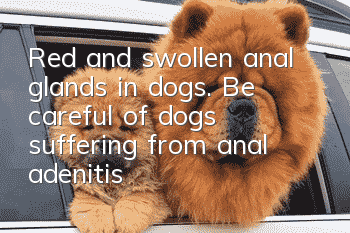Red and swollen anal glands in dogs. Be careful of dogs suffering from anal adenitis

How to express anal glands
Anal adenitis is a common disease in dogs. Many owners have heard of it, but they may not know much about its causes and treatment methods. Now I will introduce it to you.
The anal glands are a pair of exocrine glands located in the skin and mucous membranes on both sides of the anus and are common to all carnivores. Its main function is to secrete some pungent odor as its own marker. The anal glands are located at the 4 or 8 o'clock position of the anal skin and mucosa, with their openings facing outward. When the anus of dogs and cats contracts, attentive owners may notice two tiny pinpoint eyes and a slight grey-brown discharge.
Symptoms of anal adenitis
Anal adenitis can be divided into two categories. The vast majority of them are anal gland obstruction. Because the gland opening is blocked and the anal gland secretions accumulate, swelling causes Discomfort. The other type is pain and itching caused by inflammation and suppuration in the glands. These two types of diseases often occur together. Dogs suffering from this type of disease show itching in the early stages, and their symptoms can be divided into three categories:
The first type of sick dog will drag its anus forward or rub the ground back and forth after defecation and when it is quiet.
The second type of sick dog will turn around and lick and bite around the anus, or bite the fur on the outside of the upper hind legs and the base of the tail.
The third type of symptom is that sick dogs sit in a slide shape when they are quiet. In normal dogs, the anus does not touch the ground when they are sitting in a normal sitting position. The disease often causes one hind limb to stand upright, while the other hind limb stands sideways, with the anus touching the ground. Strange gesture. It seems like a person is riding a slide. After the early symptoms appear for a period of time, if not treated in time, the sick dog will develop walking difficulties in the hind limbs. After walking a few steps, the dog will suddenly touch the anus to the ground, spread the two hind limbs, and look back at the anus. Further development can lead to anal gland ulceration, with holes appearing on one or both sides of the anus, and pus and blood flowing out.
When the condition is serious, you should go to the animal hospital for professional treatment in time.
How to prevent anal gland enlargement
As an owner, you should do prevention, daily health care and early detection to prevent further deterioration. The prevention method is very simple, that is, scientific feeding, a relatively stable diet, and preventing diarrhea and constipation in dogs. Here, we should remind dog owners that the standard for normal feces is normal feces. Normal feces should be soft strips with a certain softness and stickiness on the surface. Feces that are easy to clean, do not stick to utensils and on the floor are abnormal and can easily cause disease. Therefore, an appropriate amount of crude fiber should be added to the diet to reduce protein and bone content.
Daily health care means that every time when bathing the dog, the owner should pinch the 4 o'clock and 8 o'clock positions on both sides of the dog's anus from bottom to top. If swelling is felt, squeeze out the secretions with force. Cleaning like this at least once a month can prevent serious attacks of the disease.
- Is it better for Dogo dogs to have their ears erect or cropped? A case of Dogo dog’s ear erection surgery will tell you
- What do dogs eat to protect their stomach? It is important to protect their stomach and treat gastrointestinal diseases in dogs.
- How to tell if your dog is fat? Is your dog overweight?
- Will your dog catch a cold if you blow the air conditioner? What should you do if your dog catches a cold if you blow the air conditioner?
- What should you pay attention to when your dog drinks water? Don’t be careless when it comes to your dog’s drinking water.
- The dog's mouth bites and shakes. Why does the dog's mouth occasionally shake and bite?
- How to cut a dog's hair? Do you know how to cut a dog's hair correctly?
- Can dogs eat raw eggs? Why can’t dogs eat egg whites?
- Common Dog Problems in Summer How to Deal with Different Dog Problems
- How to keep dogs away from skin diseases. If you do this, will you see if your dog will still be infected with skin diseases?



